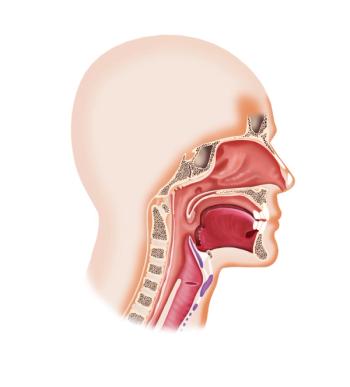
Oncology NEWS International
- Oncology NEWS International Vol 19 No 5
- Volume 19
- Issue 5
What are the Ongoing Therapeutic Challenges in Recurrent Squamous Cell Cancer of the Head and Neck?
A medical oncologist, a radiation oncologist, and a surgeon share pearls and pitfalls in their specialized approaches to managing recurrent disease.
A medical oncologist, a radiation oncologist, and a surgeon share pearls and pitfalls in their specialized approaches to managing recurrent disease.
More than half of patients with squamous cell carcinoma of the head and neck will experience disease relapse. Locoregional recurrence is most common, but there is increasing evidence that metastases and distant metastases can occur. On initial presentation, 10% of cases will show metastases, but that figure can triple to 30% upon subsequent evaluation.
"What are the primary challenges in this patient population?" asked Athanassios "Ethan" Argiris, MD, a professor of medicine and medical director of the aerodigestive cancers program at the University of Pittsburgh. First, almost all patients with recurrent disease have already received radiotherapy, which can lead to chronic toxicities from prior therapy and functional impairment. It's not simply a matter of re-treating, Dr. Argiris pointed out. Issues that need to be addressed are:
• The time interval between therapies
• The resectability of the tumor
• The patient's overall condition and comorbidities
• The potential for curative treatment
"We should individualize care, and a multimodality approach is needed," Dr. Argiris said. "Salvage may play a role, and the best example of that is salvage laryngectomy. Re-irradiation may play a role in the form of intensity-modulated radiotherapy (IMRT) or stereotactic radiosurgery. There's certainly a role for systemic therapy, including traditional chemotherapy and novel agents, mainly EGFR inhibitors, and one can combine those modalities."
At the 2010 ASTRO Multidisciplinary Head and Neck Cancer Symposium in Chandler, Ariz., Dr. Argiris moderated a session on the therapeutic challenges of recurrent squamous cell carcinoma of the head and neck (SCCHN). A trio of experts offered the pros and cons of three treatment modalities: systemic therapy, re-irradiation with or without systemic therapy, and surgery.
Pros and Cons of Systemic Therapy
Systemic therapy
Presented by DR. JAN VERMORKEN
Conventional agents for recurrent metastatic disease include methotrexate, cisplatin, fluorouracil (5-FU), vinblastine, and doxorubicin. Used as single agents, conventional chemotherapy induces a response rate of around 25% based on data culled from multiple studies, said Jan Vermorken, MD, PhD, professor of oncology and head of the medical oncology department at University Hospital Antwerp in Belgium. Newer agents include gemcitabine (Gemzar), vinorelbine (Navelbine), irinotecan (Camptosar), paclitaxel, and docetaxel (Taxotere).
Unfortunately, neither conventional nor new agents have done much to boost overall survival (OS) rates. In Europe, methotrexate has been the standard of care for recurrent metastatic disease, but global randomized trials that have compared single-agent methotrexate with single-agent cisplatin have not shown a difference in OS, Dr. Vermorken said (Eur J Cancer 40:2071-2076, 2004; Ann Oncol 10:693-700, 1999; Cancer 52:206-210, 1983; Cancer Treat Rep 69:577-581, 1985).
This lack of impact on OS also holds true for studies that have compared methotrexate with taxanes. In the European trial that Dr. Vermorken was involved in, weekly methotrexate was compared with two schedules of paclitaxel. The response rate varied from 11% to 23%, but there was still no impact on OS.
"Going a little bit into the details of this study, patients were treated for first-line recurrent metastatic disease, and methotrexate [was used] in the way that we think of as standard: 40 mg/m2 per week, which could be escalated up to 60 mg/m2 per week. Paclitaxel was given by three-hour infusion or by 24-hour infusion, but at the same dose, 175 mg/m2, which is rather high for 24-hour infusion," he said (Ann Oncol 10:693-700, 1999).
But what the trial clearly demonstrated was the value of paclitaxel in the recurrent metastatic disease setting because of a lower toxicity rate with the three-hour infusion. Specifically, stomatitis was seen less frequently with the taxanes than with methotrexate, Dr. Vermorken said.
In terms of managing toxicity, physicians must decide whether to use single-agent therapy or combination therapy. The trend in cancer care is to rely on increasingly aggressive treatment and that's especially true when dealing with recurrent metastatic disease. Studies that have evaluated a combination of cisplatin and 5-FU have noted that toxicity was moderate and that patients with a good performance status (≥ 70%) responded well to treatment (Cancer Treat Rep 70:461-464, 1986; Cancer 53:1819-1824, 1984).
A phase III trial of the EORTC Head and Neck Cancer Cooperative Group compared cisplatin, methotrexate, bleomycin, and vincristine (CABO) with cisplatin and 5-FU in combination vs single-agent cisplatin. According to the results, both hematologic and nonhematologic toxicities were worse in the combination chemotherapy arms. However, both combination treatments were superior to the single agent with regards to time-to-progression. In addition, there was no overall difference in progression-free survival (PFS) or OS among the three arms. Other trials have come up with similar results (Ann Oncol 5:521-526, 1994; J Clin Oncol 10:1245-1251, 1992 and 23:3562-3567, 2005).
"It's quite obvious if you look at toxicity, whether you're using the CABO regimen or the [cisplatin/5-FU] regimen, there's clearly more toxicity observed and reported than when you give the single agent," Dr. Vermorken advised. "So if you have a patient that is in good condition and is symptomatic, it may be preferable to use combination chemotherapy. But you have to balance that with the toxicity that will be enhanced if you give combination chemotherapy. You should realize that ultimately the outcome in terms of survival is not much different."
Finally, Dr. Vermorken, highlighted some of the targets for next-generation therapy, such as the epidermal growth factor receptor (EGFR). Nearly all patients with SCCHN express EGFR, and overexpression is correlated with late-stage disease, resistance to chemotherapy and radiation, and poor outcomes, he said.
There are currently a number of EGFR-targeting agents under investigation in head and neck cancer, including the monoclonal antibodies cetuximab (Erbitux) and panitumumab (Vectibix) as well as the tyrosine kinase inhibitors gefitinib (Iressa) and erlotinib (Tarceva) (Targ Oncol 2:73-88, 2007).
In the completed EXTREME trial, patients in the control arm were treated with cisplatin/5-FU or carboplatin/5-FU. In the experimental arm, the same regimen was combined with cetuximab. Dr. Vermorken and colleagues concluded that cetuximab plus platinum/5-FU chemotherapy improved OS when given as first-line treatment. The most common grade 3 or 4 adverse events in both arms were neutropenia and anemia; a small number of patients receiving cetuximab had grade 3-4 infusion-related reactions (N Engl J Med 359:1116-1127, 2008).
"There was no crossover in this trial, and I think that that is very important for the outcome," Dr. Vermorken said. "Patients had a maximum of six cycles of chemotherapy, and if they responded or had stabilization of disease, they continued with the monoclonal antibody until disease progression or toxicity, whatever came first. And again there was no crossover, so the patients in the control arm did not receive the monoclonal antibody."
Re-irradiation: Pluses and Minuses
Presented by DR. SHARON SPENCER
Re-irradiation
Concerns about toxicity and uncertain benefits kept re-irradiation out of the head and neck treatment mix for some time, said Sharon Spencer, MD, a professor and clinical director at the Comprehensive Cancer Center, University of Alabama in Birmingham (UAB). Early experiments with re-irradiation in nasopharyngeal carcinoma turned in survival rates ranging from 15% to 38%. Later work with interstitial re-irradiation using iridium-192 showed that local control could be achieved in about 50% of patients, but toxicity in soft tissues was still an issue (Radiology 86:900-903, 1966; Radiol Clin (Basel) 46:390-397, 1977; Cancer 39:2443-2450, 1977).
In fact, an overarching theme in the story of re-irradiation in this population is that decent survival rates can certainly be achieved, but they come at a cost of high toxicity. "I think as radiation oncologists, we get sweaty palms when a patient [with recurrent or metastatic disease] shows up in our clinic, especially when they've had radiation before. We hope that our surgeons can help us and resect the tumor so that we don't have to subject them to new treatment with radiation," Dr. Spencer said.
The combination of hyperthermia with interstitial irradiation has turned in a respectable five-year survival rate in a select group of patients.
"If you look at the patients who do the best with interstitial treatments, the size of the tumor really tells you what will happen. If [the tumor] is less than 2 cm, your recurrence rate is fairly low at 17%," Dr. Spencer said. "But if it's greater than 2 cm in size, you still have a pretty high recurrence rate. And then bigger tumors are prone to higher complication rates."
A retrospective, 32-year study conducted in the 1970s reported that nasopharyngeal cancer patients with large tumors, skull invasion, and cranial nerve problems were not candidates for re-irradiation. But in patients who were eligible, re-irradiation was done in conjunction with intracavitary radiation, usually with radium or cobalt, Dr. Spencer said. "And you could get in fairly high doses for re-irradiation and respectable five-year survival rates," he added, although complications included local soft tissue and bone necrosis (AJR Am J Roentgenol 126:107-115, 1976).
Brachytherapy is important for those patients with disease in non-nasopharyngeal sites, although survival rates do vary in published reports. For instance, a study done in the larynx demonstrated a fairly good local control rate of 61% and a survival rate at five years of 93%. Another study of external-beam radiation therapy (EBRT) and brachytherapy turned in a 20% five-year survival rate. The survival rate for patients treated with brachytherapy in subsequent trials has ranged from 61% to 91% (Radio Clin North Am 16:209-218, 1978; Radiother Oncol 23:6-15, 1992).
Dr. Spencer called attention to research led by Bahman Emami, MD, and Kenneth R. Stevens, Jr., MD. Dr. Emami's group treated 99 surgically salvaged patients with EBRT only and achieved a local control rate of 21% and a five-year survival rate of 20% (Laryngoscope 97:85-88, 1987).
"Dr. Stevens looked at about 100 patients that were treated with EBRT plus or minus brachytherapy," she said. "And he was able to note a five-year survival in his new second primary cancer patients of 37%," although in those with recurrent disease, the survival rate dropped to 17%. Nine of the 100 patients developed severe adverse normal tissue effects from re-irradiation, which Dr. Stevens' group deemed substantial but acceptable (Int J Radiat Oncol Biol Phys 29:687-689, 1994).
Relapsed patients who are not candidates for surgical resection are most likely not eligible for interstitial radiation, Dr. Spencer said. The next option would be radiation with chemotherapy. Investigators at the University of Chicago were pioneers in this field, delivering good outcomes in patients with poor prognosis using hydroxyurea, 5-FU, and radiation therapy. Eleven patients had recurrent disease after previous surgery, radiotherapy, or chemotherapy, and five patients had not received previous local therapy. Of 15 patients available for evaluation, nine had a complete response and that included five patients who had earlier local therapy. Five had a partial response, and one failed to respond. Toxicities included mild myelosuppression and mucositis (Otolaryngol Head Neck Surg 98:295-298, 1988).
FACT Head and neck cancer update Dr. Argiris will present final results from a study on pemetrexed and bevacizumab (Avastin) in recurrent/metastatic H&N squamous cell carcinoma at ASCO 2010 (abstract 5533).
Dr. Spencer and colleagues at UAB reproduced the Chicago data, looking at different dose strategies and treatment schedules: 40 Gy once a day, then 48 Gy twice a day, and 60 Gy twice a day, along with hydroxyurea and bolus 5-FU on an every-other-week schedule.
"We started out with 35 patients and were able to get most of the patients through all four courses of the treatment, but you can see, of course, there were some toxicities: 11 out of 25 had some neutropenia, and there was a death due to secondary neutropenia. And when we looked at our later complications greater than grade 3, there were four late complications: esophageal strictures, trismus, and a patient who continued to have TI [tubulointerstitial] disease. The survival at one year was 45% and at two years, 20%," she said (Int J Radiat Oncol Biol Phys 22:1051-1056, 1992).
Dr. Spencer led the RTOG 96-10 trial that treated previously irradiated patients with recurrent disease or a second primary with four weekly cycles of 5-FU (300 mg/m2 IV bolus) and hydroxyurea (1.5 g bid) along with 60 Gy in 1.5 Gy twice-daily fractions. Grade 4 toxicity occurred in 17.7% of patients, and grade 5 in 7.6%. The estimated five-year survival rate was 3.8%. The authors noted that patients who entered the study at less than one year from initial radiotherapy had a median survival of 9.8 months (Head Neck 30:281-288, 2008).
Finally, there is stereotactic body radiation therapy (SBRT) and IMRT. Researchers at Houston's M.D. Anderson Cancer Center looked at about 74 patients, some postoperatively, who were treated with concurrent chemoradiation. While outcomes were respectable, 20% of the toxicity was described as severe, Dr. Spencer pointed out (Semin Oncol 30:101-108, supplement 18, 2003).
As for SBRT, research is still pending. Multiple studies have used doses ranging from 25 to 30 Gy given in three to five fractions with toxicity ranging from 4% to 24%. Overall survival has been good, but Dr. Spencer cautioned that these results apply to patients who are specially selected for SBRT (Am J Clin Oncol online, October 23, 2009; Int J Radiat Oncol Biol Phys 74:1348-1355, 2009, and online, January 5, 2010).
While all toxicity needs to be looked at closely, spinal toxicity and late toxicity are particular areas of concern. Animal data indicate that hyperfractionated therapy can reduce spinal toxicity. A meta-analysis of four previous studies found that a cumulative BED [biologically effective dose] of 130 to 125 Gy2 is safe for the spinal cord if the initial dose does not exceed 90 Gy2 (Int J Radiat Oncol Biol Phys 66:1446-1449, 2006).
For late-effect toxicity, myelopathy has been seen two years after re-irradiation, so these patients require some longer follow up, Dr. Spencer said. In RTOG 96-10, late effects included mucosal toxicities, laryngeal and pharyngeal toxicities, and one case of hearing loss. Another RTOG trial (91-11) looked at some of the factors associated with severe late toxicities and came up with older age, advanced T stage, larynx/hypopharynx as the primary site, and neck dissection after concurrent chemoradiation (J Clin Oncol 26:3582-3589, 2008).
Surgery for Recurrent Disease
Surgery has shifted from being a primary modality for the treatment of oropharynx and larynx cancer to being a salvage modality for recurrent disease. More patients are being treated with radiation or chemoradiation, and this is especially so in U.S. tertiary centers, said Randal Weber, MD, professor and department chair of head and neck surgery at M.D. Anderson Cancer Center. "So it's important that we select our patients very carefully for salvage, and that we appropriately apply the resources to care for these patients, because it can be quite intensive getting them through this safely," he said.
When it comes to salvage surgery, the pro is the results while the con is that many patients are not even eligible. Dr. Weber outlined the checklist he goes through to decide if a patient can undergo surgery.
Surgery
Presented by DR. RANDAL WEBER
"Performance status here is very important," he said. "You really must exclude patients with serious, comorbid conditions. These operations are associated with a 3% to 5% mortality rate, prolonged hospitalization, and wound problems." Another issue to consider is cure vs palliation: Surgery may extend survival but patients may also experience functional problems such as difficulties with swallowing and speech, he said.
Also, can the disease be completely resected? "Do not do debulking procedures. If you don't think that you can completely resect the tumor with microscopically clear margins, you're not going to achieve a long-term disease control in those patients," Dr. Weber said.
Finally, consider whether the patient will require reconstruction. The majority of patients will need reconstruction so the plastic surgeon should be consulted preoperatively. "The emphasis here is that these patients really need a multidisciplinary approach, and we frequently present them in our tumor conference before we embark on the salvage," he said.
A retrospective review by Mark E. Zafereo, MD, Dr. Weber, and colleagues, looked at 1,681 patients of which 199 had locally or recently recurrent disease without distant metastasis. Only 41 of these were considered candidates for surgical salvage, Dr. Weber explained.
The patients who were recommended for surgery tended to have a longer disease-free interval, early primary tumor stage, and early recurrent tumor and overall stage (Cancer 115:5723-5733, 2009). "So you can see that the overall recurrence rate after we treat oropharyngeal cancer is fairly low, and in those that do recur locally, only a small fraction are even considered for surgery," he said.
Dr. Weber led the RTOG trial 91-11, and in a secondary analysis, the researchers sought to determine the success of salvage for persistent disease or recurrence following organ preservation therapy, determine the impact of initial treatment modality, and assess the morbidity and mortality of salvage surgery. The trial had three arms: treatment with cisplatin/5-FU, followed by surgery and/or radiation therapy for nonresponders (arm I); radiotherapy with concurrent cisplatin (arm II); or radiation therapy alone (arm III).
Of the 517 patients, 25% underwent salvage laryngectomy. Of this group, 5% experienced toxicity that required laryngectomy, while 95% had the procedure for recurrence or persistent disease (Arch Otolaryngol Head Neck Surg 129:44-49, 2003).
Dr. Weber called attention to the laryngectomy group. Survival was lower for patients who had salvage surgery than for those who remained continuously disease free at the primary site.
“With a multidisciplinary approach and a low threshold for reconstruction, you offer some of these patients a chance for survival.” - Randal Weber, MD
In the trial, the disease control rate of salvage laryngectomy was 56% in arm I, 72% in arm II, and 69% in arm III. Local-regional control was achieved in 74% of patients in arms I and II, and 90% of those in arm III. After the first failure requiring laryngectomy, there was a 10% decrement in survival.
"If you select the wrong [initial] treatment for the patient, if you try to extend organ preservation to those who perhaps aren't candidates (those with major tongue invasion, gross cartilage destruction, tumor in the soft tissues), they are more likely to fail," he said. "And when they do fail, they're going to trade off about a 10% chance for survival vs laryngectomy alone."
Complications in RTOG 91-11 included a high rate of pharyngocutaneous fistula although the figures were was not outside the norm: 25% in arm I, 29.6% in arm II, and 15% in arm III, Dr. Weber said.
"Patients with the highest risk of fistula were those who got concurrent therapy," he explained, adding that managing fistulas in these patients was very difficult. "You have poor tissue healing and you have debilitated patients; these [factors] can extensively prolong hospitalization and even require a trip back to the operating room for reconstruction."
With regard to reconstruction, the question is whether it decreases morbidity after salvage laryngectomy. A group at New York's Memorial Sloan-Kettering Cancer Center assessed the utility of the pectoralis major muscle flap (PMMF) in patients undergoing salvage total laryngectomy: 64% of the PMMF patients had chemoradiation therapy as the initial definitive treatment vs 25% in the non-PMMF group.
The authors determined that chemoradiation was the only independent predictor of pharyngocutaneous fistula formation (relative risk, 1.82; P = .02). Still, the fistula rate was similar in the PMMF (27%) group and the non-PMMF (24%) group, they said (Arch Otolaryngol Head Neck Surg 135:1019-1023, 2009).
Dr. Weber's take-home message: Avoiding salvage surgery is the best bet, but if it needs to be done, then selecting patients carefully is crucial for surgical success.
"With a multidisciplinary approach and a low threshold for reconstruction, you offer some of these patients a chance for survival," he said.
Articles in this issue
over 15 years ago
Who's Newsover 15 years ago
A health insurer actually poses the big questionover 15 years ago
State breast cancer screening programs struggle financiallyover 15 years ago
Palliative Rx for prostate ca wins OK from FDAover 15 years ago
Whole-body MRI finds breast cancer metastases earlierover 15 years ago
Brain cancer cells dodge conventional Rxover 15 years ago
Eli Lilly joins SNM imaging networkover 15 years ago
Chemo Added to Surgery Ups OS in Gastric Cancerover 15 years ago
Daley breast center opens its doorsover 15 years ago
Blood count test may predict prognosis in leukemiaNewsletter
Stay up to date on recent advances in the multidisciplinary approach to cancer.















































































